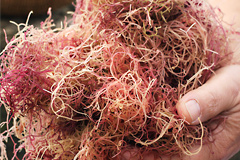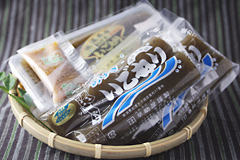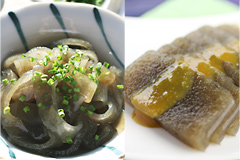Igoneri (a seaweed product) no Hayasukeya
Sado's traditional local food "igoneri"
 "Igoneri" is made by putting igogusa (egogusa) seaweed into water and boiling it well. After filtering it, all you have to do is just wait for it to become solid naturally. "Igoneri," whose only ingredient is seaweed, is low in calories and very rich in water-soluble dietary fiber. No additives are used at all, and even now Hayasukeya faithfully preserves the traditional way of making igoneri that has been handed down from old days. "Igoneri" is a common food known to all Sado islanders and can be said to be a soul food indispensable at the tables on Sado that has been popular since early times.
"Igoneri" is made by putting igogusa (egogusa) seaweed into water and boiling it well. After filtering it, all you have to do is just wait for it to become solid naturally. "Igoneri," whose only ingredient is seaweed, is low in calories and very rich in water-soluble dietary fiber. No additives are used at all, and even now Hayasukeya faithfully preserves the traditional way of making igoneri that has been handed down from old days. "Igoneri" is a common food known to all Sado islanders and can be said to be a soul food indispensable at the tables on Sado that has been popular since early times.
Sado and "igoneri"
 Sado has an old history of "igoneri." As is indicated by the theory that the "culture of ocuto (a seaweed product similar to igoneri)" in Kyushu was brought to Sado by Kitamaebune (the cargo vessels of the North Country that were actively engaged in transportation in the Sea of Japan from the early modern ages through the Meiji era), eating igoneri is a food culture that has been rooted on Sado Island from old times.
Sado has an old history of "igoneri." As is indicated by the theory that the "culture of ocuto (a seaweed product similar to igoneri)" in Kyushu was brought to Sado by Kitamaebune (the cargo vessels of the North Country that were actively engaged in transportation in the Sea of Japan from the early modern ages through the Meiji era), eating igoneri is a food culture that has been rooted on Sado Island from old times.
In the pre-war days, igoneri used to be made at each home on occasions of festivals, weddings and funerals when many people gathered, but with the change of the times, as retail stores have grown in number, more and more people have come to buy the seaweed product at those stores.
"Igoneri no Hayasukeya" used to make igoneri only during winter as a side business, but in the 1970s it started to produce the product as its one and only business. Today, you can buy Hayasukeya's igoneri at large numbers of stores on the island.
"Maki-igoneri" and "kaku-igoneri"
 "Igoneri no Hayasukeya" produces and sells two kinds of igoneri.
"Igoneri no Hayasukeya" produces and sells two kinds of igoneri.
"Maki-igoneri" (rolled igoneri), which is habitually eaten on Sado Island, is made by boiling up igogusa seaweed, filtering it, placing and spreading it on a thin plate and then rolling it after it has become solid. After chopping it up thinly, you can add some chopped Japanese leek and ginger as condiments if you like, and then you put some shoyu (soy sauce) on it and eat it. Maki-igoneri is characterized by its smooth feel.
"Kaku-igoneri" (square igoneri), which is more common in the mainland area of Niigata Prefecture, is made by boiling igogusa, filtering it, putting it in a vessel while it is hot and letting it solidify. You chop kaku-igoneri into about-5-milimeter-thick slices, and eat it after adding some vinegared miso. It would also be a good idea to add kaku-igoneri to your salad and put some dressing on it. Kaku-igoneri is characterized by its doughy feel.
More details
| name of facility | Igoneri no Hayasukeya |
|---|---|
| address | 37 Sawane-sumiyamachi, Sado City, Niigata Prefecture |
| TEL / FAX | 0259-52-6577 / 0259-52-3477 |
| website | http://www.igoneri.com (Japanese only) |
| business hours | 7:00 - 19:00 |
| a regular holiday | no holidays throughout the year |
| a parking place, a parking lot |
Parking place: available / 2 cars / Free of charge |
| payment method | cash |